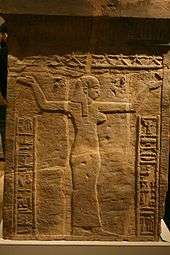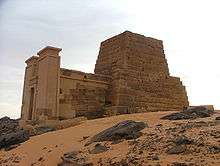Kandake
Kandake, kadake or kentake (Meroitic: 𐦲𐦷𐦲𐦡 kdke or 𐦲𐦴𐦲𐦡 ktke), often Latinised as Candace (Ancient Greek: Κανδάκη), was the Meroitic term for the sister of the king of Kush who, due to the matrilineal succession, would bear the next heir, making her a queen mother. She had her own court, probably acted as a landholder[1] and held a prominent secular role as regent.[2] Contemporary Greek and Roman sources treated it, incorrectly, as a name. The name Candace is derived from the way the word is used in the New Testament (Acts 8:27).[3][4][5]

Archaeological sources
Bas-reliefs dated to about 170 B.C. reveal the kentake Shanakdakheto, dressed in armor and wielding a spear in battle. She did not rule as queen regent or queen mother, but as a fully independent ruler. Her husband was her consort. In bas-reliefs found in the ruins of building projects she commissioned, Shanakdakheto is portrayed both alone as well as with her husband and son, who would inherit the throne by her death.
Greco-Roman sources
Pliny writes that the "Queen of the Ethiopians" bore the title Candace, and indicates that the Ethiopians had conquered ancient Syria and the Mediterranean.[6]
In 25 BC the Kush kandake Amanirenas, as reported by Strabo, attacked the city of Syene, today's Aswan, in territory of the Roman Empire; Emperor Augustus destroyed the city of Napata in retaliation.[7][8]
Cassius Dio wrote that Kandake's army advanced as far as the Elephantine in Egypt, but Petronius defeated them and took Napata, their capital, and other cities.[9]
Four African queens were known to the Greco-Roman world as the "Candaces": Amanishakheto, Amanirenas, Nawidemak, and Malegereabar.[10]
Biblical usage
_Mauritshuis_282.jpg)
In the New Testament, a treasury official of "Candace, queen of the Ethiopians", returning from a trip to Jerusalem, met with Philip the Evangelist:
Now an angel of the Lord said to Philip, "Rise and go toward the south to the road that goes down from Jerusalem to Gaza." This is a desert place. And he rose and went. And there was an Ethiopian, a eunuch, a court official of Candace, queen of the Ethiopians, who was in charge of all her treasure. He had come to Jerusalem to worship[11]
He discussed with Philip the meaning of a perplexing passage from the Book of Isaiah.[12] Philip explained the scripture to him and he was promptly baptised in some nearby water. The eunuch 'went on his way, rejoicing',[13] and presumably therefore reported back on his conversion to the Kandake.
Alexandrian legend

A legend in the Alexander romance claims that "Candace of Meroë" fought Alexander the Great.[14] In fact, Alexander never attacked Nubia and never attempted to move further south than the oasis of Siwa in Egypt.[15][16] The story is that when Alexander attempted to conquer her lands in 332 BC, she arranged her armies strategically to meet him and was present on a war elephant when he approached. Having assessed the strength of her armies, Alexander decided to withdraw from Nubia, heading to Egypt instead. Another story claims that Alexander and Candace had a romantic encounter.
These accounts originate from "The Alexander Romance" by an unknown writer called Pseudo-Callisthenes, and the work is largely a fictionalized and grandiose account of Alexander's life.[15] It is commonly quoted, but there seems to be no historical reference to this event from Alexander's time. The whole story of Alexander and Candace's encounter appears to be legendary.[16][15]
John Malalas has mixed the Pseudo-Callisthenes material with other and wrote about the affair of Alexander with Kandake, adding that they got married. Malalas also wrote that Kandake was an Indian queen and Alexander met her during his Indian campaign.[17][18][19]
Kandakes of Kush

- Shanakdakhete (177 BC–155 BC) (earliest known ruling queen)
- Amanirenas (40 BC–10 BC)
- Amanishakheto (c. 10 BC–1 AD)
- Amanitore (1–20 AD)
- Amantitere (22–41 AD)
- Amanikhatashan (62–85 AD)
- Maleqorobar (266–283 AD)
- Lahideamani (306-314 AD)[20]
References
- Lohwasser, Angelika (1999). "Die Frau im antiken Sudan" (PDF). p. 131.CS1 maint: ref=harv (link)
- Khan, Dan'el (2012). "The Queen Mother in the Kingdom of Kush: Status, Power and Cultic Role". Teshura le-Zafrira: Studies in the Bible, the History of Israel, and the Ancient Near East Presented to Zafrira Ben-Barak of the University of Haifa. pp. 67–68.CS1 maint: ref=harv (link)
- Lobban, Richard A. Jr. (2003). Historical Dictionary of Ancient and Medieval Nubia. Lanham, MD: Scarecrow Press. ISBN 978-0-8108-6578-5.
- Miriam Ma'at-ka-re Monges (2005). "Kush". In Molefi Kete Asante, Ama Mazama (ed.). Encyclopedia of Black Studies. Sage. p. 302. ISBN 978-0-7619-2762-4.
- Fage, John. A History of Africa. Routledge. p. 115. ISBN 1317797272.
- Turner, Sharon (1834). The Sacred History of the World, as Displayed in the Creation and Subsequent Events to the Deluge: Attempted to be Philosophically Considered, in a Series of Letters to a Son,. Vol. 2. Longman. pp. 480–482.
- Fluehr-Lobban, Carolyn (August 20, 1998). "Nubian Queens in the Nile Valley and Afro-Asiatic Cultural History" (PDF). Ninth International Conference for Nubian Studies. Museum of Fine Arts, Boston U.S.A. Retrieved 2018-06-07.
- Budge, Sir Ernest Alfred Wallis (1911). Cook's handbook for Egypt and the Egyptian Sûdân. T. Cook & Son. p. 737.
- Dio Cassius, Histories, §54.5.4
- Harris 2014, p. 29.
- Acts 8:26-27
- Isaiah 53:7-8
- Acts 8:39
- Jones, David E. (1997). Women Warriors: A History. Brassey. p. 82. ISBN 978-1-57488-106-6.
- Goldenberg, David M. (2009). The Curse of Ham: Race and Slavery in Early Judaism, Christianity, and Islam. Princeton University Press. p. 64. ISBN 1-4008-2854-6.
- Morgan, John Robert; Morgan, J. R.; Stoneman, Richard (1994). Greek Fiction: The Greek Novel in Context. Psychology Press. pp. 117–118. ISBN 978-0-415-08507-6.
- Malalas, Chronography, §8.194-195
- Nawotka, Krzysztof; Wojciechowska, Agnieszka (October 2018). The Alexander Romance: History and Literature. Barkhuis. p. 226. ISBN 978-9492444714.
- Moore, Kenneth Royce (June 2018). Brill's Companion to the Reception of Alexander the Great. BRILL. p. 464. ISBN 978-9004285071.
- Mark, Joshua. "The Candaces of Meroe". Ancient History Encyclopedia. Ancient History Encyclopedia Limited. Retrieved 2 June 2019.
- Harris, G.L.A. (2014). Living Legends and Full Agency: Implications of Repealing the Combat Exclusion Policy. CRC Press. ISBN 978-1-4665-1378-5.CS1 maint: ref=harv (link)